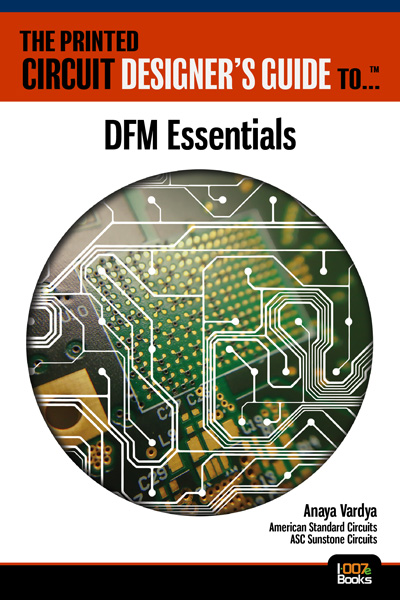-

-
News
News Highlights
- Books
Featured Books
- pcb007 Magazine
Latest Issues
Current Issue
The Legislative Outlook: Helping or Hurting?
This month, we examine the rules and laws shaping the current global business landscape and how these factors may open some doors but may also complicate business operations, making profitability more challenging.

Advancing the Advanced Materials Discussion
Moore’s Law is no more, and the advanced material solutions to grapple with this reality are surprising, stunning, and perhaps a bit daunting. Buckle up for a dive into advanced materials and a glimpse into the next chapters of electronics manufacturing.

Inventing the Future With SEL
Two years after launching its state-of-the-art PCB facility, SEL shares lessons in vision, execution, and innovation, plus insights from industry icons and technology leaders shaping the future of PCB fabrication.
- Articles
- Columns
- Links
- Media kit
||| MENU - pcb007 Magazine
Creating a Design Constraint Strategy
July 24, 2025 | I-Connect007 Editorial TeamEstimated reading time: 2 minutes
Feature Q&A With Kris Moyer, Global Electronics Association
Most designers learn how to set their design constraints through trial and error. EDA vendors’ guidelines explain how to use their particular tools’ constraints, and IPC standards offer a roadmap, but PCB designers usually develop their own unique styles for setting constraints.
Is there a set of best practices for setting constraints? That’s what I asked Global Electronics Association design instructor Kris Moyer, who covers design constraints in his classes. In this interview, Kris discusses how to identify PCB design requirements and set design constraints tightly enough for performance but flexible enough for manufacturing limitations.
What pre-layout analysis should be performed before you begin setting constraints?
Kris Moyer: There are several analyses that should be completed before setting constraints. These include the following:
- Timing/signal integrity: Used to set controlled impedance, termination, length matching and max length, and layer restrictions for digital signals.
- SPICE/power integrity analysis: Used to define the power distribution network (PDN) limits, the current requirements (trace widths), and voltage clearance requirements (Cu-Cu clearance).
- Thermal analysis: Used to determine how many plane layers, the copper weight of the plane layers, temperature rise of the traces (also used to define trace width), and any heat-sinking needed.
- Structural/mechanical analysis: This is the vibration, shock, and other environmental impacts to the design. It’s used to trade off between how many copper layers vs. board thickness for the stackup, and it is also used to evaluate the number and locations of mount holes or other support structures for the board. This analysis also leads to placement restrictions, such as specific placement of tall parts due to the design of the enclosure, or heavy/high mass parts due to special support structures designed into the housing, etc.
- Material analysis: This is an investigation of any special materials that may be needed, such as RF materials, flex materials, etc. These all have an impact on the stackup of the PCB and often lead to routing restrictions. For instance, you can only route the RF signals on the RF layers, or you have fewer routing layers available in the flex sections vs. the rigid sections of a rigid-flex board, limiting your ability to route signals from one rigid section to the next.
To continue reading this Q&A, which originally appeared in the July 2025 Design007 Magazine, click here.
Testimonial
"Advertising in PCB007 Magazine has been a great way to showcase our bare board testers to the right audience. The I-Connect007 team makes the process smooth and professional. We’re proud to be featured in such a trusted publication."
Klaus Koziol - atgSuggested Items
New Podcast Episode: “Bonding Innovation: How Adhesives and Coatings Are Powering the Next Generation of Electronics”
11/05/2025 | I-Connect007I-Connect007 has released of a new episode in its Voices of the Industry podcast series, titled “Bonding Innovation: How Adhesives and Coatings Are Powering the Next Generation of Electronics.” Hosted by Nolan Johnson, this insightful discussion dives deep into the evolving world of adhesives and coatings—materials that are redefining performance, reliability, and design in modern electronics manufacturing. Dymax's Doug Katze, a leading expert in adhesive technologies, delivers what can only be described as a master class on how these critical materials are adapting to meet rapidly changing market demands.
Target Condition: Distribution of Power—Denounce the Ounce
11/05/2025 | Kelly Dack -- Column: Target ConditionHave you ever wondered why the PCB design segment uses ounces to describe copper thickness? There’s a story behind all of this—a story that’s old, dusty, and more than a little absurd. (Note that I didn’t add “Like many of us.”) Legend has it that back in the days of copper tinkers and roofing tradesmen, the standard was set when a craftsman hammered out a sheet of copper until it weighed one ounce, when its area conveniently matched the square of the king’s foot.
NEDME 2025 Draws Strong Northwest Crowd, Builds on Tradition of Regional Collaboration
10/31/2025 | NEDMEThe NW Electronics Design & Manufacturing Expo (NEDME) 2025 once again brought together the Pacific Northwest community for a full day of learning, networking, and industry connections.
Keysight Advances Quantum Engineering with New System-Level Simulation Solution
10/30/2025 | BUSINESS WIREKeysight Technologies, Inc. announced the release of Quantum System Analysis, a breakthrough Electronic Design Automation (EDA) solution that enables quantum engineers to simulate and optimize quantum systems at the system level.
WestDev Announces Advanced Thermal Analysis Integration for Pulsonix PCB Design Suite
10/29/2025 | WestDev Ltd.Pulsonix, the industry-leading PCB design software from WestDev Ltd., announced a major enhancement to its design ecosystem: a direct interface between Pulsonix and ADAM Research's TRM (Thermal Risk Management) analysis software.


